No witty introduction to this one – we’re diving head first today!
I work in Corporate America… and I can’t tell you how many times I want to claw my eyeballs out of their sockets with the nearest sharp utensil when I read a terrible email from a colleague. Why does this happen? I have to assume a lack of proper preparation for workplace environments is to blame.
Over the summer, I took a course about teaching technical communication. Because of that course, I have narrowed down the area of college writing I want to teach – writing in the technical world for engineering and science students. I think it’s important for students bound for a corporate, professional workplace after they graduate understand how to effectively communicate through writing.
Our world has most definitely reached the digital age in recent years – communication will never be the same as a result. It seems that we, in corporate environments, converse with our colleagues over email and IM systems more than we pick up the phone. I personally like this, because I find it easier to be more concise with my words and convey my point clearly. Granted, there are some times where it’s always better (and easier) to pick up the phone or schedule some face time with your co-workers, but it’s essential to corporate success that people understand how to communicate through written words.
Some tips I’ve come to hold near and dear when composing work emails, documents, and more are as follows. If you can remind yourself of these when writing a co-worker, you’ll be off to a great start.
- Keep it simple and be quick, clear, and concise as possible. Short and sweet is the best way to go – you don’t want to bog your readers down with pages and pages and pages to read. Explain your message clearly, be concise, and be sure to get to your point as quick as you can – if you are a busy person, you should assume your reader is just as time-poor as you are.
- Write as you would talk – except use the proper version of your language. Your voice is what the reader will hear when they read your message, so make it conversational. Don’t be afraid to let your personality shine through, either – these are your words, and you are attaching your name to the message… so own it!
- Break your message into short paragraphs and avoid long sentences. Reading words on a screen can be daunting for some, and easier for others. Accommodate your audience – breaking up your paragraphs and keeping sentences short will allow your message to be easier to read. I tend to get overwhelmed when a colleague sends me a long email and it’s all in one paragraph. I have literally copied and pasted it into a Word document to break it down, so I can receive their message a little more clearly. Think about this the next time you don’t use paragraph breaks!!
- Maintain a positive tone. It’s tough to read emotion through written word sometimes (especially in text messages!), so it’s important to be positive throughout your message. This will help your reader see the point you’re trying to make without negativity.
- PROOFREAD AND EDIT BEFORE SENDING! I will say this over and over until my students understand this must happen EVERY SINGLE TIME a message is sent to someone through written words. I won’t lie – I’ve caught some serious typos or found that my message didn’t make sense when I reread it before sending. I suggest reading your message to yourself out loud to see if it makes sense. Things seem to read differently when you hear them aloud versus when they stay on the page. Don’t hesitate to have someone take a glance too – a fresh pair of eyes can catch things we don’t the first few times around.
Of course, there will be exceptions. Case in point, my boss and I are very close – if someone read our emails, you’d be able to tell that right away. We use emoticons and sometimes shorthand, but most of the time we keep it super professional – our company records all communication for legal purposes, so we want to be sure we’re professional when on the record. We start with the usual address (“Hi Nicole,”) in the first round, but then usually it’s a conversation back and forth in the replies that follow. The important thing here to be sure you gauge your audience and use communication to accommodate accordingly.
If you have questions or want more advice about writing for work or your professional environment, let’s chat!

